There was a moment of play when this toy literally took off – achieved lift-off and defied gravity – and we knew from the collective shouts of our kids that we’d found a winner. This is a toy that takes some investment to get to work properly. But with a little focus, there are big moments of surprise, delight, and joy. And parents, you might even learn more about electricity than you ever thought you wanted to know (trust me, you do). Your kids might learn a thing or too as well.

Snap Circuits by Elenco is a line of science kits that teach kids about electricity. We initially started with a smaller version of the kit, and had so much fun with it we decided to try the larger version, the Snap Circuits Jr. Select.
While this path gave us a familiarity with the toy that allowed us to move faster into play, I wouldn’t say it’s necessary to start with the small kit. The Snap Circuits Jr. Select kit is complete with a printed instruction booklet with 60 project ideas, from small and straightforward to sprawling and complex. With a moment’s attention to the instructions, you can figure out how the 2-D instructions correspond with the physical pieces, and fun accelerates.

First Impressions
There’s a few first impressions that are worth mentioning. I remember being a little intimidated by the toy – I don’t know much about electricity, so this was a learning experience for me as much as for our kids. The intimidation factor was one reason we started with the smaller kit (and we like to start small when it comes to toys – you just never really know what’s going to hold our kids’ attention).
It’s a Toy About Electricity – and It’s Safe
I admit that when I bought the kit, I was a little unsure about safety. I knew the kit needed batteries (not included), and it appears that the kit involves bare metal connectors — would we need to be cautious about electric shock?
I’m happy to say that we’ve had big and little hands all over the metal connectors, and shocks are not a worry at all. This is a safe toy! And even though the age range starts at 8, our 5 and 3-year-olds were present at the table and happily helped snap pieces together — although the dexterity needed to snap the pieces in place were (a little) challenging to our 5-year-old.
Thoughtful Design
The designers of the Snap Circuits electric science kits have put considerable thought into designing an aesthetically pleasing toy that’s welcoming to small hands. Most of the pieces are large, brightly colored plastic and labeled numerically to correspond with the printed directions.
The snaps (how pieces connect together) fit easily and snuggly and make a satisfying click when secured in place. Each piece in the kit is sturdy and easily withstood multiple (accidental) drops from table height.
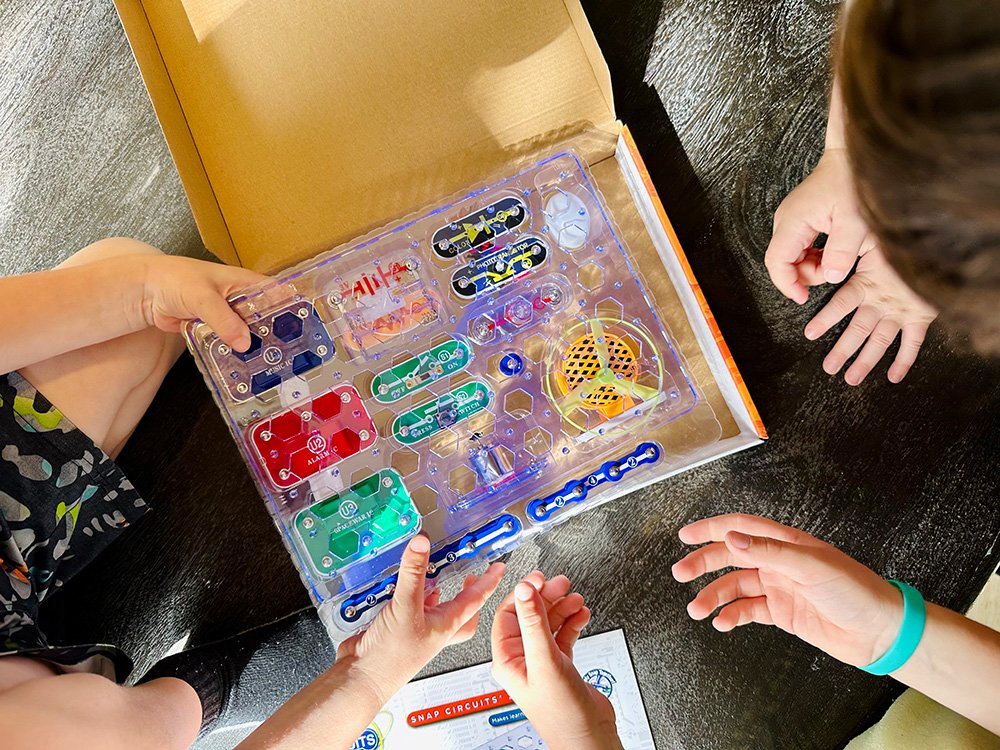
There’s a plastic block that forms the base of each project – and the x and y-axis are labeled so as to make placement easy. I watched my 8-year-old refer to this grid often in the instructions to make sure he was assembling the kit per the printed instructions. There are lots of little touches like this in the design of this kit. It makes assembly and play approachable for the age range described.

Printed Instructions – Good but Not Perfect ( ★★★★☆ )
In general, the instructions are great for kids. Each project includes an explanation of electrical concepts along with a 2-D diagram of what the finished project should look like. I do, however, have a (minor) beef with the instructions.
With this particular project, there can be 3 (and even 4) levels of connecting pieces, like a layer cake. The 2-D rendering in the instructions makes it tough to see the arrangement of vertical layers. We were able to figure them out together, but left alone my 8-year-old would not have been able to piece some of the more complex projects together to match the instructions. There’s room for improvement, but ultimately, it’s not a barrier to play.
What’s Included In the Box
FYI Batteries are NOT included. You’ll need to make sure you have some on hand to accompany the project.
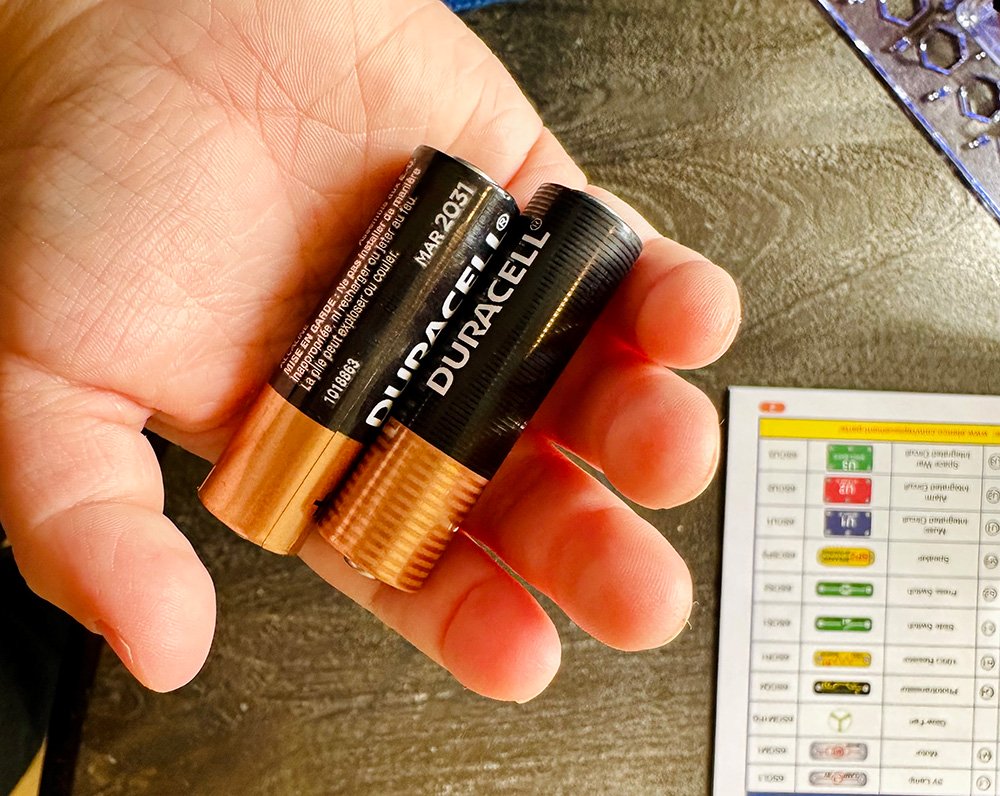
What is included in the box:
- Handy storage packaging
- Rectangular project grid with labeled x and y axis
- Instruction booklet w/60+ projects
- 3 sound boxes
- Music
- Alarm
- Spacewar
- 2 on/off switches
- Battery / power box
- A colored light connector
- An opaque egg for use with the light connector ^^
- A phototransistor
- A speaker
- A spinning motor
- A fan spinner blade
- A single color light connector
- A resistance connector (100ohms)
- Connection pieces of 5,4,3,2 and 1 units of length
- 2 connecting wires for long-distance connections
Play
Our 8-year-old ended up directing the assembly of the kits in their various configurations. Our 5-year-old helped with snapping the connectors together. Our 3-year-old was brought in to press various switches, cover the phototransistor and more.
It helped to have an adult handy as some of the pieces have a directionality to them – if they are counter to the direction of the current, the circuit won’t be completed (look at me learning about electricity) and the project doesn’t work (or doesn’t work as expected.
We found that the kids had the most fun with secondary play. For instance, on one of the sound projects, after the project was completed you could change the quality of the sound by covering and uncovering the phototransistor.
By far the most fun we had (so far) was playing with the fan and motor. In one configuration, turning on a switch would start spinning the fan. When the switch was released, the fan would shoot up in the air!
Indeed, the first time this happened was a bit of a shock as the fan buzzed up past our faces — hovered about 3 feet off the surface of the table, and gently descended. Once we knew what to expect, we could give the fan a clear path of travel away from faces.
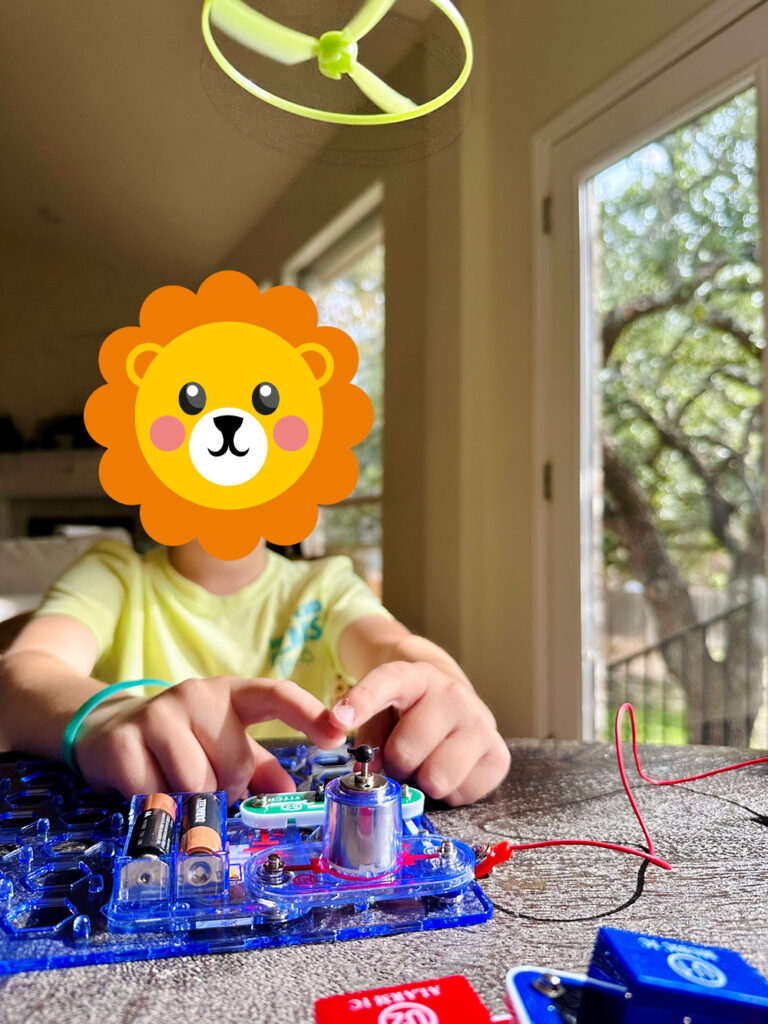
Rest assured, this is a safe kit. And even if the rising fan had come in contact with kids, it had a circular ring that meant that any contact would be harmless.
What I wouldn’t recommend doing (and I’m sure the manufacturer would second this) is to attach a second (this one, 3-battery) pack from another kit 🤪 ⚡️ With 5 batteries in series, the fan shot up and got about 10 feet of air, spun on the ceiling and then drifted gently back down to earth. We (I, dad) couldn’t resist the experiment, but ultimately dismantled it in the name of safety — once we had experienced the sheer power of quintuple AA batteries.
Even with the original 2-battery power configuration, our kids took turns for the better part of the hour pressing the switch to complete the circuit and shoot the fan up into the air. With the 3 and 5-year old occupied, our 8-year-old went to get our smaller (original) Snap Circuits ‘Basic Electricity’ kit and started playing with that.
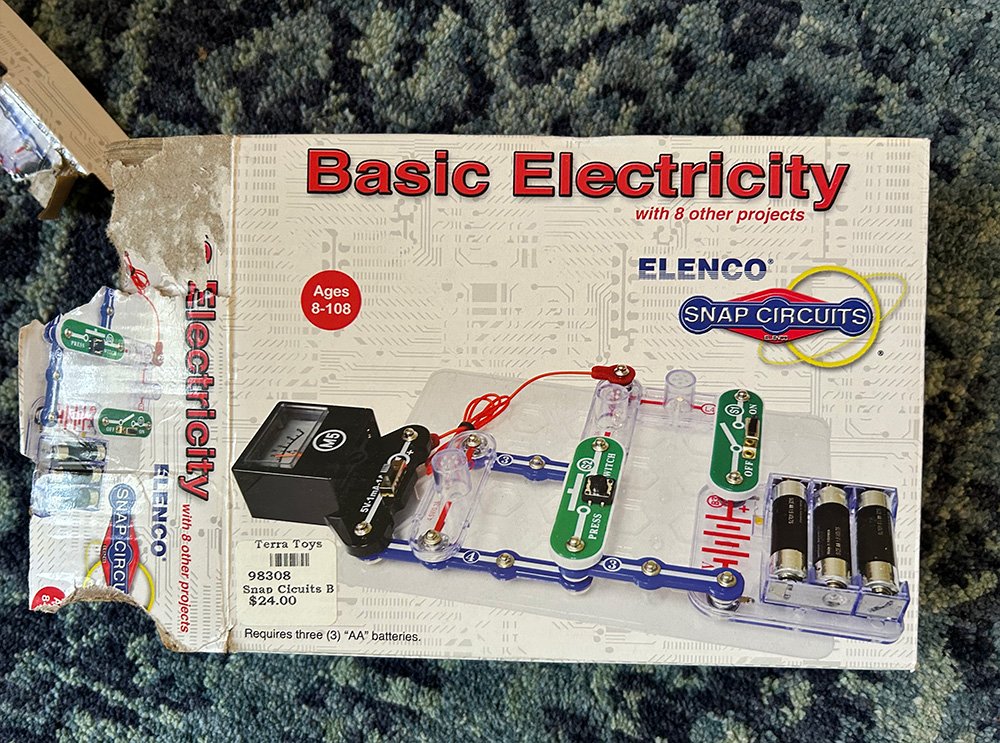
After a while, our kindergartener started creating Frankenstein circuits, seeing how long, how weird and how unwieldy he could build a circuit that still (somehow) worked.
Learning About Electricity
It’s hard to know what was learned – I’d say definitely the basics of completing a circuit. In addition, we discussed the directionality of current flow across the various pieces. The fan and motor were great teaching companions here – since the fan worked differently depending on the direction. In one configuration the fan would fly into the air. In the other, the fan created downward force that kept it rooted in place. It was fun to feel the airflow pushing up from the table, keeping the fan in place.
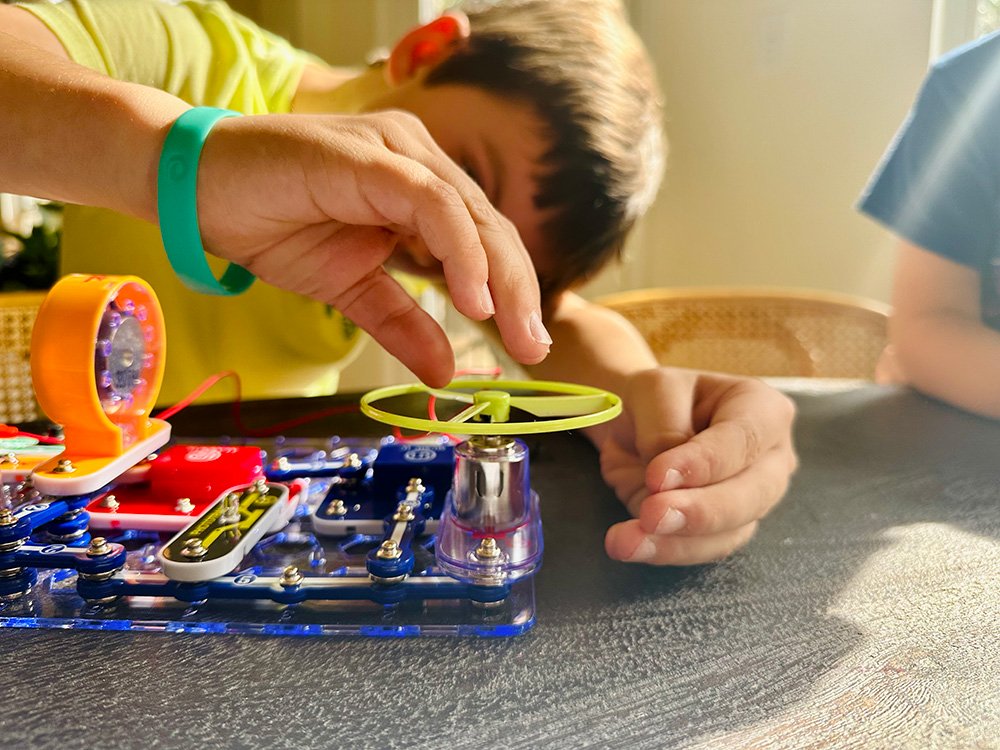
Cleanup
Cleanup is fairly straightforward — legos this ain’t! The plastic holder that comes with the kit means that each piece has a home. It didn’t have to be this way – many times toys in boxes come with loose pieces. But the Snap Circuits Jr. Select’s holder helped the kiddos put the toy away cleanly, pack up up in the box and put it on the shelf. I have a minor nit that the box once opened didn’t completely re-seal, so as a storage container it’s not perfect (and it would be easy to make a tab so the cardboard lip stays sealed).
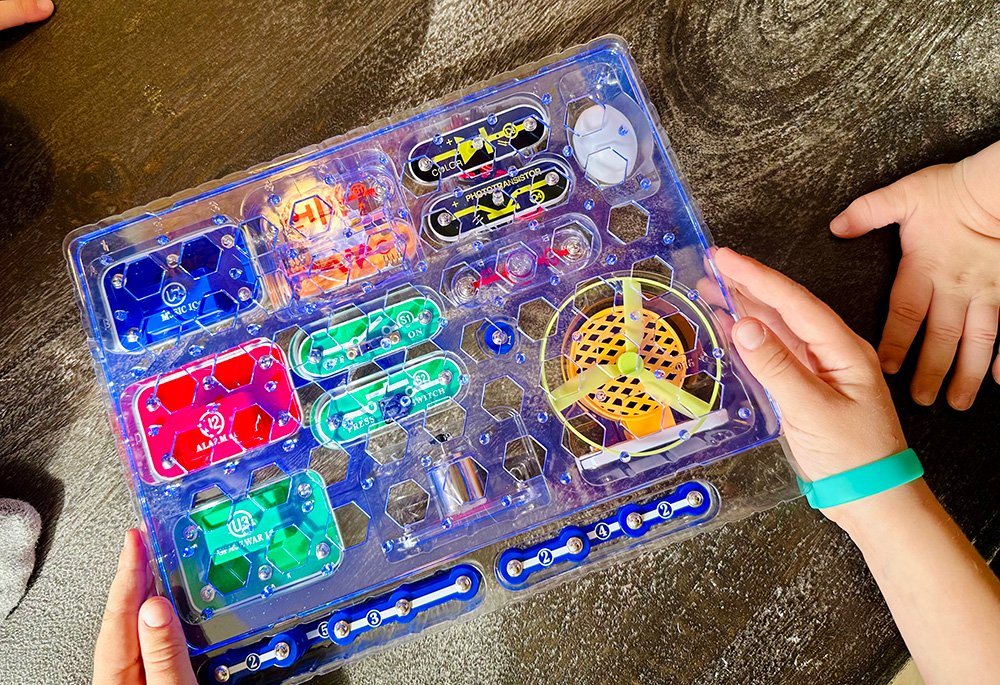
Pros and Cons
Pros
The sound and kinetic fan pieces distinguish this STEM kit from the smaller Circuit Jr science kits – in a big way. Secondary play is as much fun as the initial construction. In that sense, it’s very much like Legos. As an educational toy, the learning piece is sneaky (in the best way). You have to understand certain fundamentals in order to make things work (like completing a circuit). And the outcome (like having the fan fly into the air) makes the construction journey well worth it.
In addition, the kids (5 and 8) were able to pick up enough on their own to play independently. The kids played with this kit for over an hour all told.
Cons
Many of the pieces in this kit didn’t seem to hold my kids attention. The music boxes and speaker took up a lot of the kit, but didn’t seem super interesting once constructed (with the exception of the phototransistor changing the sound of music – very cool). The moving pieces (motor and fan) and lighted connectors were the most interesting so far. We haven’t played with the kit at night, which I bet would bring an additional layer to play and interest.
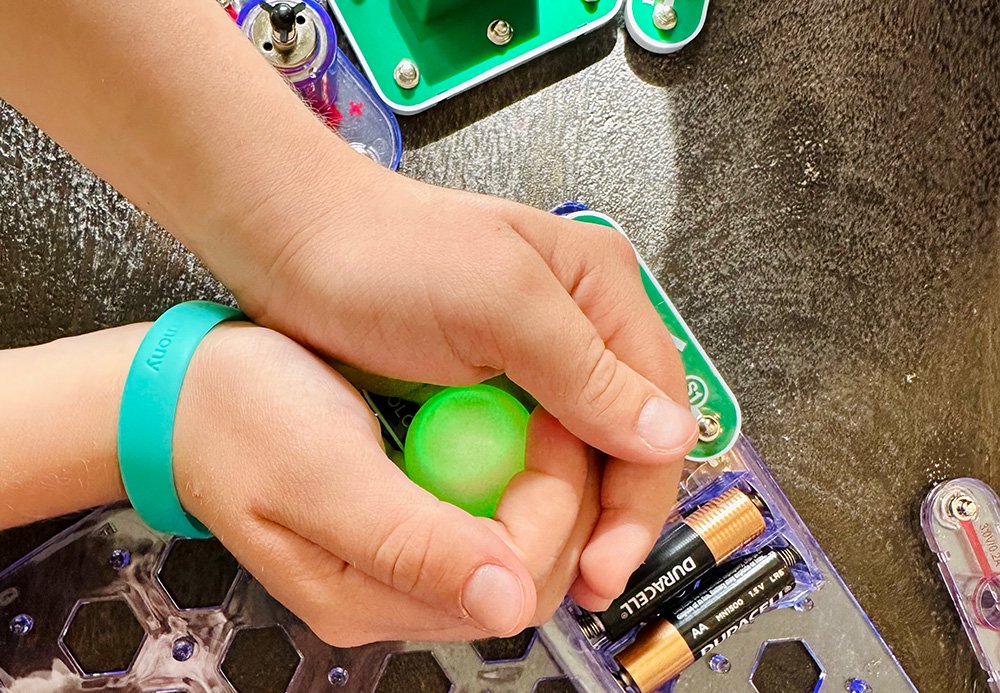
(2 AA) batteries weren’t included – that could easily lead to disappointment if this were given as a present.
Part of the con was just wanting more: I saw the possibility of this type of science kit and I wanted to see more motors, more light, and more movement.
Overall
I would highly recommend the Snap Circuits Jr. Select SC-130 Electronics Exploration Kit. It’s hard to imagine a more perfect fusion between a screen-free, educational and engrossing toy. Despite a few minor shortcomings, this kit has a ton of potential for free play once kids figure out the core concepts around electricity (completing a circuit). Shop All Circuit Kits.

Kinetic Creatures is a participant in the Amazon Services LLC Associates Program, an affiliate advertising program designed to provide a means for sites to earn advertising fees by advertising and linking to Amazon.com. This means that whenever you purchase a product on Amazon through a link on our website, we may earn a small commission at no extra cost to you. We only recommend products that we truly believe in and think will be valuable to our readers. Your support through purchasing via our affiliate links helps us to keep creating content and inspiring families to connect through play, movement, and outdoor adventures. Thank you for your support!
